Whenever I notice vestigial ashtrays on airplanes, I get a bit anxious. The idea that hundreds of passengers were allowed to carelessly brandish open flames and generate thick clouds of smoke while inflight is unnerving. Still, despite my modern-day anxieties, people smoked on airplanes for decades —and at movie theaters, the doctor’s office, in classrooms, at the gym… even in delivery rooms.
Throughout the first seven decades of the twentieth century, cigarettes were everywhere. If you were born before the ‘90s, you probably remember candy cigarettes. Or chomping on chewing gum cigarettes. Like the hollow ones that were filled with a pinch of flour? When you “exhaled,” the flour puffed out like a fun-filled plume of smoke.
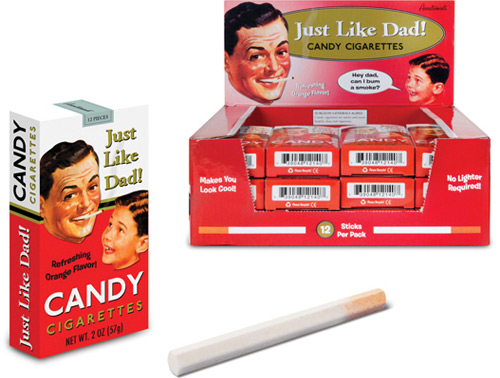
So when my friend Henry gave me five delightfully detailed miniature cigarette packs, and asked me to figure out where they came from, I wasn’t going to be shocked if they turned out to be dollhouse props or some type of toy.
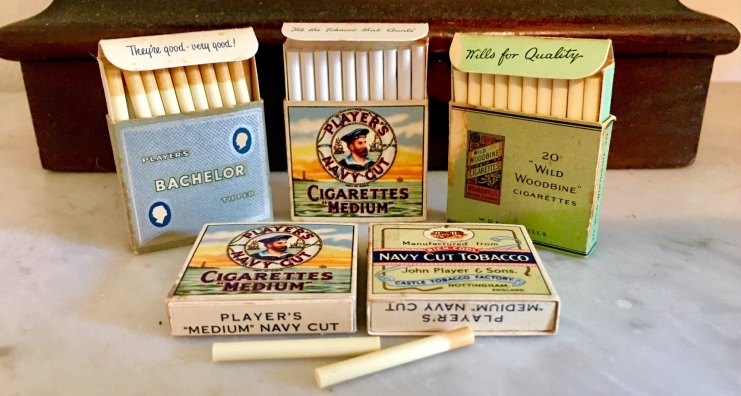
Since the miniscule cigarettes are plastic rather than wood or paper, I guessed they were manufactured in the 1950s or ’60s.
And it turns out they were indeed toys.
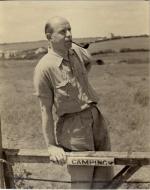
In 1932, a Brit named Hilary “Harry” Fisher Page founded a toy company called Kiddicraft. A writer, inventor, and psychologist, by the 1950s, Page and his company had become focused on a line of highly realistic miniature foods and shopping items marketed as “Kiddicraft Miniatures.” These tiny toys promoted imaginative play while reinforcing counting, organizing, and manual dexterity. The product line even boasted a checkbook and play money.
In addition to cigarettes, (because no child can survive on smokey-treats alone), Kiddicraft Miniatures included popular cereals, soaps, savouries, (such as Mudd’s of Grimsby’s Lincolnshire Fishcakes … yum!), health items, (such as Crooke’s Halibut Oil Capsules), jams, soft drinks, dairy products, canned goods, condiments, teas, and of course, spirits and liquors. Because what child doesn’t need a tiny half-liter of Haig’s Gold Label or Hennessy? Just like the bottle Mummy hides in her apron!
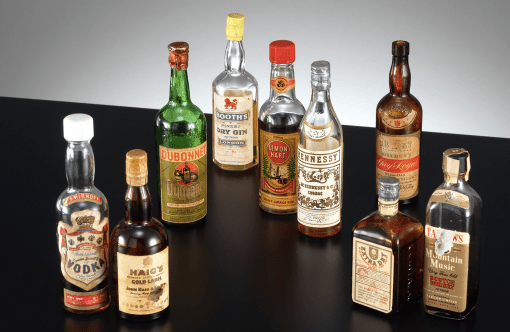
And that tiny bottle of Hennessy would have looked precisely like Mum’s. Each Kiddicraft Miniature, whether a soup can, an egg crate, or a pack of smokes, was an exact, licensed replica of the actual product. And Page insisted on quality. The original packaging for my Player’s cigarettes proudly proclaims that the product is a “masterpiece of fine printing.”
It then goes on to describe the manufacturing process. In detail.
“There are six colours on the back and front areas. Each colour was photographed separately from a standard packet of 20 Players, using a separate colour-filter to pick out each colour. Six different sets of colour-plates were made and each miniature was printed six times, applying a different colour each time … This called for accuracy and extreme skill in the art of fine printing.”
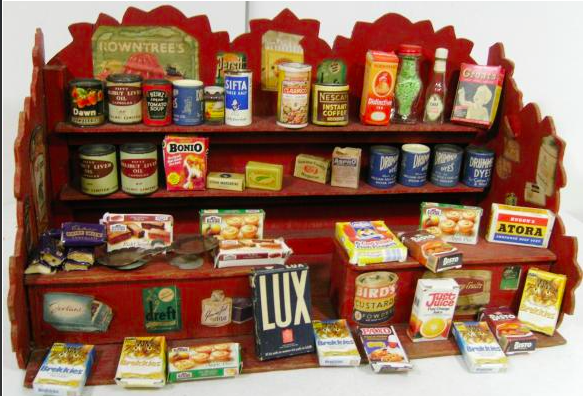
But wait. That’s just the printing process. There’s more.
“The tiny shells are too small to be glued in any machine. They have to be hand-glued, hand-assembled and hand-filled.”
But what about the 20 tiny cigarettes? How are they made? Don’t worry. The package explains that too.
“The little plastic cigarettes are made from high-impact polystyrene from a 400-cavity mould capable of producing 8000 cigarettes a minute, all within one thousandth of an inch of the same diameter. Thousands of pounds were spent in the production of this little Kiddicraft miniature.”
Thousands of pounds were spent producing this miniature? Really? A single Kiddicraft Miniature retailed for less than 1 pound.
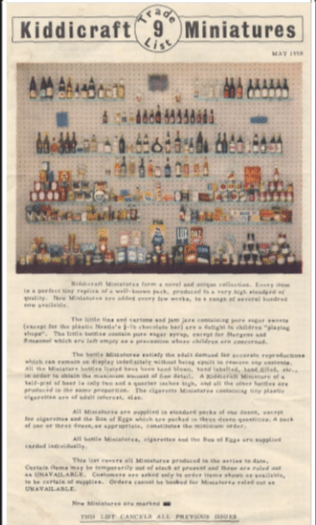
The math here might make you pause. And that pause would be warranted. While Kiddicraft produced more than 200 different miniatures—and the toys were a hit—the company was in trouble. Burdened by a growing anxiety about their inability to fulfill production demands, Harry Fisher Page committed suicide in 1957. The same year that my tiny cigarette packs were in production. He left behind his wife, Oreline, and their young twin daughters.
Despite his untimely death, Harry Fisher Page was an innovator in the world of toy design. He pioneered brand licensing in toys and the use of plastics in toy manufacturing. He was also one of the earliest visionaries to connect psychology and toy design, developing playthings that purposefully corresponded to the stages of childhood development, a theory laid out in his book Playtime in the First Five Years.
In addition to revolutionizing how we think about and make toys, Harry Fisher Page was also the original inventor of the interlocking building blocks that would later became synonymous with Lego. Years before Lego introduced their blocks, Page’s company produced similar sets. That might seem hard to believe, considering most people have never heard of Page, but the toy catalogs speak for themselves.
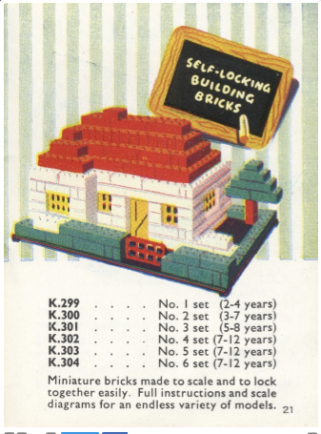
Plus, Lego’s chairman admitted it in court.
During a 1987 court battle with Tyco, Lego’s then 66-year-old chairman, Godtfred Kirk Christiansen, admitted under oath that in 1947, Harry Fisher Page had given him samples of interlocking play blocks. Two years later, Lego had begun production of their own blocks, adapting Page’s patented design by just one tenth of a millimeter and slightly altering the interlocking studs to improve connectivity. Decades later, in 1981, Lego paid an out-of-court settlement of 45,000 pounds to the then owners of Page’s company, allowing Lego to acquire any residual rights related to Page’s patents. Page’s widow never pursued the issue.
After Page’s death, Kiddicraft went through several acquisitions. Finally, in 1989, Fisher Price purchased the company and still maintains ownership today, depsite dropping the brand name in the mid ’90s. Still, it was a bit ironic to learn that Kiddicraft is owned by Fisher Price.
Why? Well, since they came off the production line in 1957, our five little Kiddicraft Miniature cigarette packs have journeyed all the way from England, to where I currently live in Western New York. And it just so happens that Fisher Price’s headquarters are located in East Aurora, New York—just a little over an hour’s drive from my home.
So it seems that my Kiddicraft Miniatures, which Henry gave me to figure out where they came from, have followed the same journey as Harry Fisher Page’s company. A journey from England, across the ocean, to Western New York—a journey that makes me think that perhaps it’s equally as important to figure out where something belongs, as it is to figure out where it came from.
And so, the final stop for Henry’s little toy cigarettes has appropriately been The Strong National Museum of Play in Rochester, New York. Itself just an hour and a half down the thruway from Fisher-Price headquarters, the museum is home to the world’s largest collection of toys, dolls, games, electronic games and other artifacts related to play. With more than 520,000 items in that collection, Henry’s cigarettes—and a tiny piece of Harry Fisher Page’s legacy—will now be preserved for many generations to come.
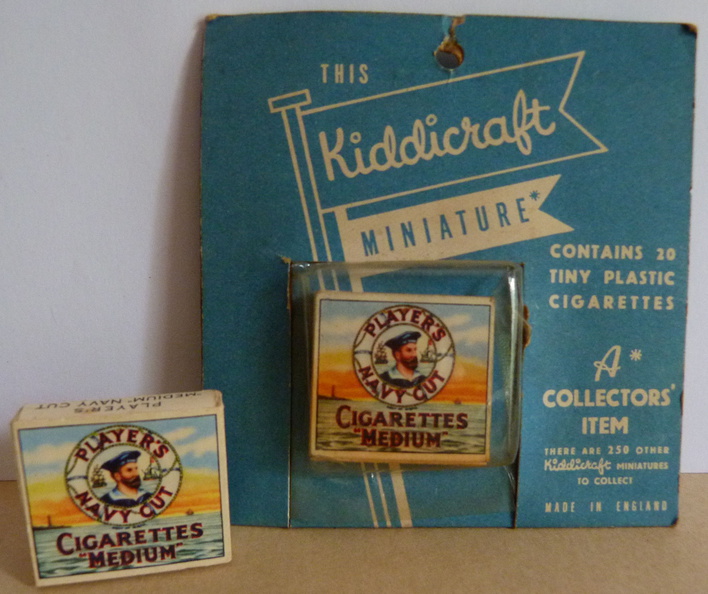
I am grateful to Henry for entrusting me with these tiny treasures and allowing me to help them find their way home. Thank you Henry!